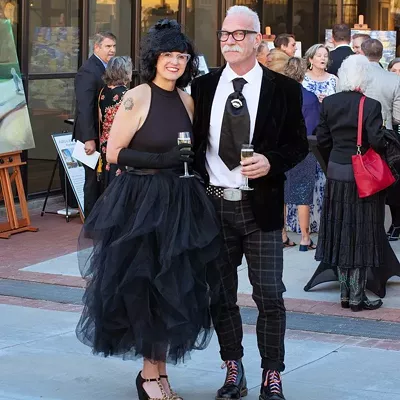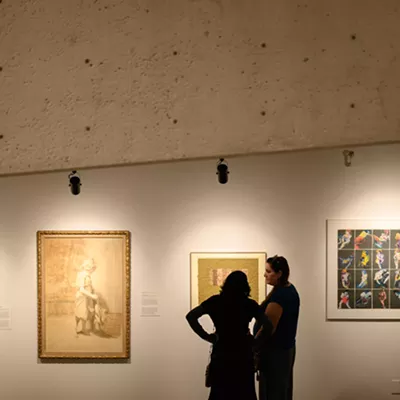Joel-Peter Witkin’s next exhibition is at the Louvre in Paris next year.
It will no doubt be a mesmerizing show, but Tucsonans don’t have to fly across the Atlantic to see his lauded photography.
Right now, the renowned photographer is exhibiting work in Tucson, at Etherton Gallery’s new digs in Barrio Viejo.
Joel-Peter Witkin: Journeys of the Soul is a career survey of more than 50 works, including his rarely seen drawings. His elaborate staged photos honor all humankind—the living and the dead, the saints and the sinners, the sick and the well, and nude beauties of every imaginable gender identity.
But hurry. The show will close at the end of the day next Saturday, Nov. 27.
The show is timely for both the artist and the gallerist, Terry Etherton. The gallery is celebrating its 40th anniversary, its recent move from downtown to the barrio and its long relationship with Witkin.
The photographer, now 82 years old, has had an enormous reputation for years, including overseas. (“The French are crazy about him,” Etherton says.) Etherton has been following Witkin for decades, and exhibited his work in the 1980s, when the artist first began to make his name. And there have been many Witkin shows at Etherton ever since.
“Inaugurating our new space with an exhibition of Witkin’s work is a fitting tribute both to the gallery’s and Joel’s legacy, and our longstanding friendship,” Etherton says. These days, Etherton Galley is Witkin’s sole representative in the United States. His other rep is in Paris.
Throughout his career, Witkin has taken weeks or even months to make a single work. First, he would made drawings to plot out the piece. (His small black-and-white sketches hanging in the show are charming.) Then, with his camera, he created his intricate still-life tableaux, as complicated as a movie set, with big casts of nudes or animals or skeletons.
Once he was satisfied with a photo, he would batter his master negative, scratching it, tearing, throwing wet tissue at it, collaging, toning by hand, coloring with paint or encaustic wax. As a result, no two prints are alike.
The finished images are extraordinary. Often inspired by religion and art history, Witkin’s pieces show compassion for the suffering and empathy towards non-conformers. Among the pieces, all of them gelatin silver print, we see a man hobbling on painfully bent legs; in another, the head of a dead man is in a tray. A man with a missing an arm holds a skull, a memento mori reminding us that that we will die someday.
Witkin makes exquisite portraits of women, not unusual. More unusually, but he also seeks out people of non-conforming identity.
In one of his early works, from 1988, “The Graces” pictures three beautiful nudes. Standing in a row, they mimic the lovely Three Graces of Greek myth. Unlike the Grecian goddesses, all three of these beauties have penises. Two also have breasts and one does not. Witkin simply honors who they are. In many ways, he has been ahead of his time.
One of the most sumptuous tableaux mixes his interest in both art history and religion.
“Waiting for de Chirico in the Artist’s Section of Purgatory” combines both traditions. It adapts pieces of paintings by the surrealist Chirico, putting them into one scary place. Witkin manages to include Chirico’s “Mystery and Melancholy of a Street” and its famous scary road to nowhere, along with a giant Greek head and a tower falling down. The religious part comes with the prisoners in this crowded purgatory; these artists are stuck here until they have done enough penance for their sins.
Etherton’s own favorite is “Cupid and Centaur in the Museum of Love,” in which the lovers have turned into skeletons. He loves it partly for Witkin’s masterly use of encaustic. But he acknowledges Witkin’s work can be challenging.
“I really wanted to open the gallery with something like this, to make a statement,” Etherton says. “This is not for everybody. They may not like the subject matter. But even people who don’t like this work understand how good it is.”
The Witkin show, the first to be
in the new gallery space on Convent, has demonstrated how well the new place works, Etherton says.
The 1987 building, nestled between century-old adobes, was specifically designed to house art. The original owner, Bill Small, a wealthy collector and newspaper man who owned the Tucson Citizen and, for a time, the Arizona Daily Star, enlisted his architect son William to create a place with plenty of rooms to display his art and lots of storage as well.
“It was brilliant of Bill,” Etherton says. “All of the rooms are exactly the size we need. And I’ve lived in apartments smaller” than the massive storage space.
Etherton’s former gallery, in the historic Oddfellow building at Sixth Avenue and Broadway, has 3,600 square feet, more that the Convent building’s 3,300 square feet. But the many rooms of the new place give Etherton far more wall space to hang the art.
The layout, he says, precisely meets his needs.
The Journey of the Soul, the currently featured show, hangs in a group of accessible rooms at the front of the gallery. And the rooms at the back provide space for permanent exhibitions and smaller shows.
“We can do rotating shows, kind of great quick exhibitions.”
One wall will always sport a sneak preview of what’s coming next. Right now the wall holds several images from a show scheduled to open Dec. 4. Photog Michael O’Neill will show his richly colored photographs of extraordinary yogis around the world.
Just beyond that space, a big room is dedicated to large-scale paintings. “Nude Descending Staircase,” a much-admired work by the late James G. Davis, is already up.
Jim Waid, another beloved Tucson artist, is showing one of his semi-abstract paintings inspired by the colors and shapes of the Sonoran Desert. An adviser and friend of Bill Small years ago, Waid will always have a spot in the painting room, Etherton says.
There’s also a huge work room, a kitchen and, happily, an immense outdoor patio that allows Etherton to show sculptures for the first time. It’s already graced with Fox McGrew’s revered desert sculptures.
And unlike the former building, with its infamous 27 stairs to the top, the back door here is accessible to all, from wheelchair users to workers carrying heavy boxes.
“The Fed Ex guys are happy,” Etherton says.
Joel-Peter Witkin: Journeys of the Soul
Through Nov. 27, Etherton Gallery, 340 S. Convent Ave.
Tuesday to Thursday, 11 a.m. to 5 p.m.
Free entry; free parking on street and behind building
520-624-7370; ethertongallery.com












